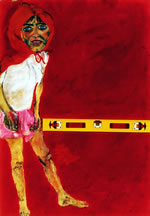 |
|
|
|
|
|
|
| Dalit Gurevich (Israel, lives and works in NY)
The subject matter of this work is taken from one of the most famous fairy tales known in the western world: “Little Red Riding Hood.” The moral lesson of this classic story as well as its interpretation varies. The apparent moral for children (and notably tamer) is that they should not speak to strangers. However, a deeper and more sinister interpretation lies in-between the lines of the story; one with sexual references both to the female protagonist and to the wolf. Little Red Riding Hood has been seen as a metaphor for sexual awakening. In this interpretation, the red cloak symbolizes the menstrual cycle and the entry into puberty and womanhood. The other interpretation refers to a warning against becoming a "working girl” since the red cloak was a characteristic of prostitutes in 17th century France. The wolf completes the picture as being a symbol of a male sexual predator.
|
 |
| Little Red Riding Hood |
| Interestingly,this painting is a self-portrait. Thus, it raises many questions regarding how the artist perceives herself within this ambiguous character. Ms. Gurevich depicts herself as a fragile child-woman, her expression projects pain and somewhat sadness and her posture and body are distorted and unbalanced. The artist directly associates the tone of the painting with her feelings towards her body image during her adolescence years.The presence of the wolf is replaced with a level, attached to the painting. The object, with is phallic reference is directed to the girl’s vagina. The threatening position of the level brings about the notion of female libido and reinforces the sexual symbolic references of this folk tale. |
|
| |
|
|
|
|
|